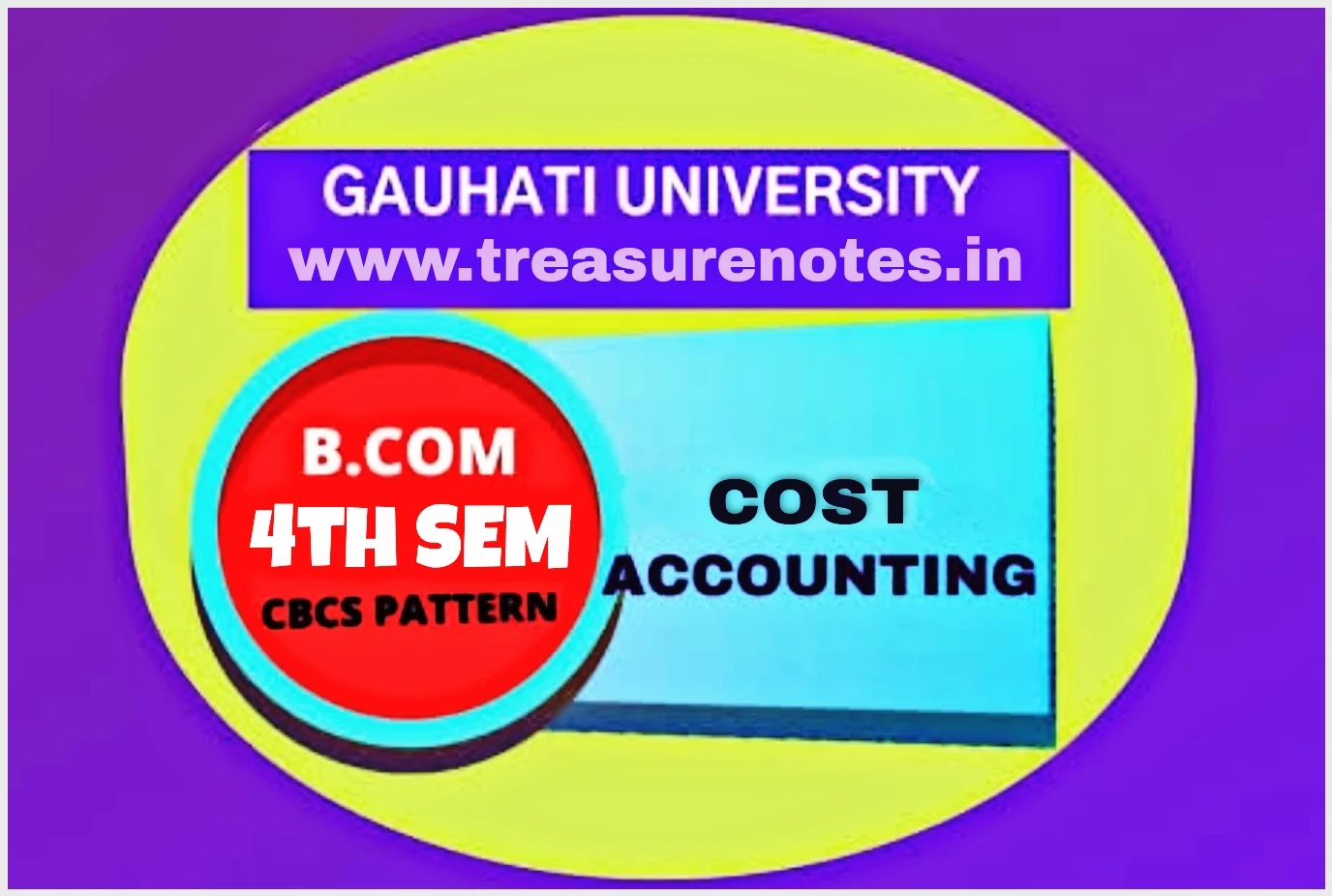Cost Accounting
UNIT-1 INTRODUCTION
Q1(A): Fill in the blanks with most appropriate words:
(i)__________ is the main function of cost accounting.
Ans: Cost ascertainment.
(ii)___________is the aggregate of indirect material cost, indirect wages and indirect expenses.
Ans: Overhead
(iii) The aggregate of direct materials, direct wages and direct expenses is known as__________.
Ans: Prime cost.
(iv)_________is a unit of product, service or time in relation to which cost may be ascertained.
Ans: Cost Unit
(v) Prime cost + Factory overhead =_________
Ans: Works cost.
(vi) Cost accounting records both monetary and _________units.
Ans : Physical.
(vii) is a statement whose detailed information about total cost is depicted.
Ans: Cost sheet.
Guwahati University, Cost Accounting B.COM 4th semester Notes
Q1(B): State whether the following statements is True or False:
(i) Differential cost is the change in the cost due to change in activity from one level to another.
Ans: True .
(ii) Depreciation is the example of semi-variable cost.
Ans: False
(iii) Costing systems are classified according to nature of operations. Ans: False
(iv) Sunk costs are not relevant to decision making.
Ans: True.
(v) A cost unit is regarded as a unit of product, service or time in relation to which cost may be ascertained or expressed.
Ans: True.
(vi) Cost accounting is needed by non-profit organisations like schools, colleges and hospitals.
Ans: True
(vii) Cost accounting is generally concerned with internal reportingi n managerial requirement.
Ans: True
(viii) Cost is express in Rs. per physical unit (like meter, kg, km,tonne etc.)
Ans: True
(ix) Cost accounting is not required if the price is beyond control of the firm.
Ans: False
(x) All limited companies registered under Companies Act, 1956 must maintained cost accounts records.
Ans: False.
(xi) Opportunity cost is the value of benefit sacrificed in favour of an alternative course of action.
Ans: True
(xii) Cost of production is equal to prime cost plus works cost.
Ans: False
(xiii) Direct cost is one which can be conveniently identified with and charged to a particular unit of cost.
Ans: True
(xiv) Fixed cost per unit decreases with rise in output and increases with fall in output.
Ans: True
Cost Accounting B.COM 4th semester Notes For Guwahati University,
Short Answer Type Questions:
Q2. State the meaning of 'cost' in respect of cost accounting.
Ans: Cost is a measurement in monetary terms of the amount of resources used for the purpose of production of goods or rendering services. Cost in simple words, means the total of all expenses. Cost is also defined as the amount of expenditure (actual or notional) incurred on or attributable to a given thing or to ascertain the cost of a given thing.
Q3. Define costing.
Ans :According to ICMA, London, costing is "The process of accounting for cost which begins with the recording of income and expenditure and ends with the preparation of periodical costs."
Q4. What is Cost Accounting ?
Ans :According to Kohler, cost accounting, "is that branch of accounting dealing with the classification, recording, summarization and reporting of current and prospective costs." In simple words, cost accounting is the process of accounting for cost which begins with the incurrence of costs and ends with the control of costs. It is a formal system of accounting by means of which cost of products, services or activities are ascertained and controlled.
Q5. What is cost unit?
Ans: A cost unit refers to a units of product, service or time in relation to which costs may be ascertained or expresses. In other words, cost unit is the units of output for which cost is ascertained. For example, the cost of air-conditioner is ascertained per unit.
Q6. What is cost centre?
Ans: A cost centre is a location, person or item of equipment for which cost may be ascertained or used for the purpose of control. In simple words, it is a sub-division of the organization to which costs can be charged. A cost centre can be (a) Location (b) Person (c) an item of equipment.
Q7. What are the elements of cost?
Ans :Total cost of a product is composed of three elements. They are material, labour and expenses. Each of these elements may be further divided into two parts Direct and Indirect, i.e., direct materials, direct labour, direct expenses and indirect materials, indirect labour and indirect expenses.
Q8. What is prime cost?
Ans: Costs are primarily divided into direct costs and indirect costs. Direct costs consist of direct materials, direct wages (labour) and direct expenses. The sum of these three direct expenses is known as prime cost. Prime cost = Direct material + Direct labour + Direct expenses.
Q9. What is a cost sheet?
Ans: Cost sheet or statement of cost is a statement prepared at a given interval of time showing the various elements of cost of a product or a service or a job in total as well as per unit of output produced during the period. Costs are shown in an analytical and in detail form .It is Presented in a Columnar Form.
***
Also Read :
Bcom 4th Sem(Honours) GU All Subject Previous Year Question Paper "Click Here"
We hope the G.U Cost Accounting Notes for B.Com 4th sem provided on this page helps in your Semester exam preparation. If you have any questions, ping us through the comment section below and we will get back to you as soon as possible.

